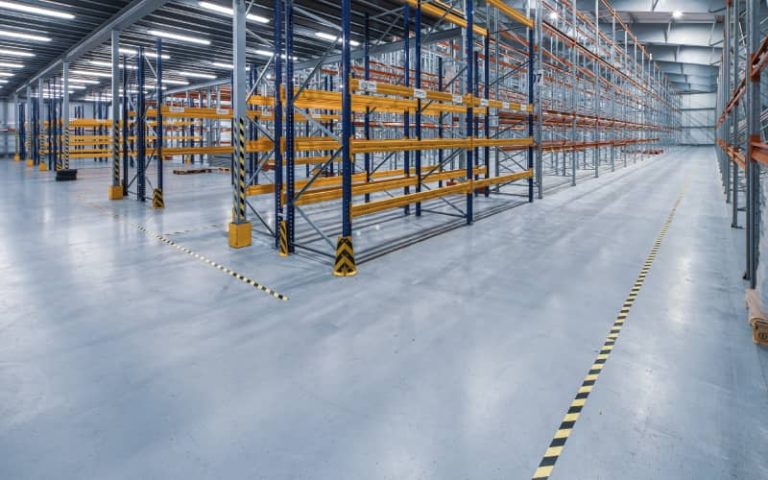Modern warehouses are under constant pressure to store more, move faster, and stay safe. But when your inventory includes long, bulky, or irregularly shaped items like lumber, pipe, tubing, or furniture, standard pallet racking just doesn’t cut it. You need a cantilever racking system.
Whether you’re managing a small fabrication shop or a large-scale distribution center, cantilever racks provide a flexible, high-capacity storage solution for materials that don’t fit traditional storage models. How much do you know about cantilever warehouse racks? Let’s put your knowledge to the test and explain everything you need to know, starting with the basics.
What Are Cantilever Racks?
Cantilever racks are specialized warehouse storage systems designed to store long, oversized, or odd-shaped materials. You may sometimes hear people refer to them as cantilever pallet racking, but in reality, they are not designed to hold pallets. Unlike pallet racking systems that rely on front-facing beams, cantilever storage racks have horizontal arms that extend from vertical uprights. This allows open access.
The core components of cantilever rack storage include:
- Uprights: The vertical columns that support the structure.
- Bases: Anchor the upright to the ground and provide stability.
- Arms: Horizontal supports that hold the load; can be straight or inclined.
- Bracing: Horizontal or diagonal-cross members that stabilize the frame.
Because there are no front columns, forklifts and side loaders can access inventory directly from the front, reducing handling time.
Types of Cantilever Racking Systems
Cantilever racking systems can vary in strength, structure, and use case, depending on the materials they’re designed to hold. You need to choose the right type for your operations.
Light-Duty vs. Heavy-Duty Systems
Light-duty cantilever racks are ideal for storing items like lightweight plastic pipes, trim pieces, or aluminum profiles. These systems are often roll-formed from thinner steel and designed for lower weight capacities. They’re easy to adjust and cost-effective for lighter inventory.
Heavy-duty cantilever racks, by contrast, are built from structural steel and engineered to handle massive loads, up to thousands of pounds per arm in some cases. These are the systems used in steel service centers, lumber yards, and industrial manufacturing environments. If your materials are dense, long, and heavy, a heavy-duty cantilever rack is a must.
Single-Sided vs. Double-Sided Configurations
The orientation of the rack is also a critical design consideration.
Single-sided cantilever racks are designed to sit flush against a wall, making them ideal for perimeter storage or smaller facilities. Double-sided racks, on the other hand, are placed in the middle of an aisle or open area, allowing access to stored materials from both sides. This layout maximizes storage density but requires wider aisles for safe forklift access.
Structural Steel vs. Roll-Formed Racking
Structural cantilever racks are typically made from hot-rolled steel and designed for durability under demanding conditions. They can withstand impacts and are suited for heavy loads and harsh environments.
Roll-formed racks, though lighter and easier to assemble, are less durable and generally reserved for lighter-duty applications.
Adjustable vs. Fixed Arm Systems
If you have regular changes to inventory, adjustable arms provide the flexibility to reconfigure the rack as needed. These arms can be repositioned along the upright to accommodate different product sizes or to add more levels. Fixed arms, however, offer greater stability for operations where inventory specs remain consistent.
Outdoor-Ready Systems
Some cantilever storage racks are engineered specifically for outdoor use. These typically feature galvanized finishes or powder-coated surfaces to resist rust, UV exposure, and moisture. They’re common in lumber yards and construction material depots where inventory is frequently exposed to the elements.
Common Applications and Industries
Cantilever racks are used across multiple industries wherever inventory can’t be palletized or boxed easily. Here are some of the common storage uses and industries where cantilever racking systems are utilized.
| STORAGE USES | INDUSTRIES |
| Lumber and Building Materials: Boards, plywood, drywall, beams. | Manufacturing |
| Metal and Industrial Goods: Pipes, rebar, steel tubing, extrusions. | Wholesale distribution |
| Furniture and Retail: Mattresses, sofas, long cartons, rolled textiles. | Construction supply |
| Mechanical and Plumbing Supply: PVC, conduit, ductwork. | Automotive and aerospace |
| Lumber and Building Materials: Boards, plywood, drywall, beams. | Retail and home improvement |
How to Design a Cantilever Racking System
Designing a safe and efficient cantilever system requires professional planning to ensure the system performs under load and aligns with your operational flow. Here are some of the key steps:
1. Define Your Load Requirements
Start with the materials you need to store:
- Length, width, height, and weight per unit
- Do you need rigid or flexible solutions?
- Point loads or uniform distribution?
Flexible materials like conduit need closer arm spacing to avoid sagging. Heavy items require high-capacity arms and structurally reinforced uprights.
2. Calculate Load Capacities
Each arm must support a specific portion of the total weight. Here’s the formula for calculating cantilever rack load capacities.
Total load per level = arm capacity × number of arms
You’ll also want to add a safety margin, typically up to 50% of the expected load, and confirm your total vertical capacity on each upright.
3. Choose Arm and Upright Spacing
Typically, arm spacing will be every three to six feet, depending on load length and weight. Your upright spacing will be determined by the number of bays and aisle configuration.
4. Optimize Layout
You need to ensure you have enough clearance for forklifts, especially when turning and whether you want single-sided or double-sided cantilever racking.
5. Plan for Environmental Conditions
For outdoor use, choose galvanized or powder-coated cantilever storage racks. In your load calculations for outdoor applications, you’ll also need to factor in any added weight from snow or ice and the impact of UV degradation and temperature expansion/contraction over time.
Cantilever Racking Engineering and Installation
Understanding the mechanics of cantilever systems is critical when you’re planning a safe and reliable installation, which is why professional cantilever rack installers are necessary. Manufacturer specifications and stamped engineering drawings are essential, especially for heavy-duty cantilever racks and multi-level installations.
Even with the right equipment and design, however, you need expert installation to make sure the system performs as intended. Even small deviations during installation can result in compromised load capacity and long-term safety issues.
Preparing the Site and Slab
Proper installation begins with the floor. The concrete slab must be clean, level, and capable of supporting the load transferred through the rack’s base plates. Any cracks, uneven surfaces, or weak spots must be addressed before anchoring begins.
The slab’s thickness and reinforcement must also meet the specifications provided by the rack manufacturer or engineer of record.
Anchoring and Leveling
Each upright must be securely anchored to the concrete slab using the correct anchor bolts. These bolts should be torqued to precise values to ensure a solid connection.
Leveling is equally important. A plumb upright ensures equal weight distribution, while level arms prevent material sagging and improve stability.
Assembling the Frame and Arms
After anchoring the uprights, installers connect the bracing that holds the structure rigid. Depending on the design, this might include horizontal braces, diagonal cross-bracing, or K-bracing. These braces resist torsional forces and keep the rack from swaying under load.
Once the frame is stable, arms are attached to the uprights using bolts or locking pins. Each arm must be secured according to the torque specifications provided by the manufacturer, and in the correct orientation.
Signage and Compliance
Before the system is put into use, it’s critical to post load capacity signage on each bay or upright. This provides a clear reference for operators and is often required by OSHA and local building codes.
Why Professional Cantilever Storage Rack Installers Matter
Given the structural demands and safety considerations involved, most facilities rely on professional cantilever racking installers. These specialists ensure correct assembly and provide documentation for inspection, permitting, and long-term maintenance. Proper installation is the foundation for everything that follows. Get it wrong, and even the best-designed rack won’t perform to spec.
Inspection, Safety, and Maintenance of Cantilever Racks
A cantilever rack system is a long-term investment, and like any critical piece of infrastructure, it requires consistent monitoring to remain safe and effective. Over time, even well-built systems can develop issues due to wear, impact, or overloading. Regular inspections are a key part of warehouse safety.
Visual Inspections
The first line of defense is a regularly scheduled visual inspection, typically monthly or quarterly, depending on the volume and type of material being stored.
Inspectors should check for common signs of wear and damage, such as:
- Bent or sagging arms
- Cracked welds at arm joints
- Rust or corrosion
- Loose or missing bolts.
Base plates and anchoring points should also be examined to look for signs that the rack has shifted or begun to lift off the slab. And don’t forget about bracing. Any missing or damaged horizontal or diagonal bracing can dramatically reduce the structural stability of the rack. Likewise, arm stops should be intact and secure to prevent rolling materials from falling.
After-Impact Checks
Whenever a forklift or piece of equipment strikes the rack—even lightly—an immediate inspection should follow. Structural steel can hide hairline fractures, and this can impact stability over time. Impact damage is one of the most common causes of rack failure and must never be ignored.
Load Compliance
Racks should never be loaded beyond their rated capacity. Each arm or upright is designed to carry a specific load, and exceeding that limit risks structural failure.
Preventive Maintenance
Regular maintenance tasks can prolong the life of your cantilever system. This includes touch-up painting to prevent rust, replacing worn or damaged hardware, and keeping the rack area clear of debris or obstructions. Racks used in outdoor environments may require more frequent maintenance due to exposure.
Documentation and Safety Audits
Maintaining inspection logs, repair records, and updated engineering documents helps support compliance with OSHA regulations and prepares your operation for audits. Annual third-party inspections (especially for heavy-duty or high-bay systems) can add an extra layer of protection and peace of mind.
Choosing the Right Cantilever Rack Supplier
Building a properly engineered and installed system starts with choosing the right supplier. Look for cantilever racking system suppliers who:
- Have extensive experience with cantilever warehouse racks and complex storage systems
- Can provide you with stamped engineering drawings, certified load ratings, and help with permitting if needed
- Offer custom warehouse planning, layouts, and consultation services
- Have experience sourcing both new and used equipment
- Support code compliance, engineering, and installation guidance
One note here: avoid mixing components from different manufacturers unless verified by a structural engineer. This can void warranties and create unsafe mismatches.
Smarter Storage with Cantilever Racking
Cantilever racking systems provide the flexibility you need for handling oversized, non-palletized, or irregular inventory. Whether you’re storing heavy steel beams or lightweight trim boards, the right system makes all the difference in safety, efficiency, and scalability.
Conesco Storage Systems is a nationwide leader in material handling equipment, with decades of experience designing and installing cantilever pallet racking solutions for even the most complex warehouse environments. With a vast inventory of new and used equipment, a deep understanding of code requirements and safety best practices, and a team of design engineers on staff, Conesco can help you plan, buy, and install the right cantilever warehouse racks for your operation.
FAQS — Frequently Asked Questions About Cantilever Racking Systems
Is it more cost-effective to buy new or used cantilever racks?
Used systems often offer 30–50% savings but require thorough inspection and may need modifications. New systems come with warranties and current engineering standards. The decision depends on your load requirements, timeline, and long-term plans.
How do I know if I need light-duty or heavy-duty cantilever racks?
Generally, if your materials weigh over 1,000 pounds per arm or include dense items like steel beams, lumber bundles, or heavy machinery parts, you’ll need heavy-duty systems. Light-duty works for items under 500 pounds per arm like PVC pipe, aluminum profiles, or lightweight panels.
Can cantilever racks be reconfigured or expanded later?
Yes, especially systems with adjustable arms. You can typically add height, extend runs, or relocate arms to accommodate changing inventory. However, any modifications should be reviewed by a structural engineer to ensure load capacity isn’t compromised.
What happens if a forklift hits my cantilever rack?
Stop using the affected area immediately and have it inspected by a qualified person. Even minor impacts can cause structural damage that isn’t immediately visible. Never assume the rack is safe without proper inspection.
Can I install cantilever racks myself?
Professional installation is strongly recommended. Improper installation can void warranties and create serious safety hazards.
How long do cantilever racks last?
With proper maintenance, quality cantilever systems can last 20–30 years or more. Outdoor systems may require more frequent maintenance but can still provide decades of service with galvanized or powder-coated finishes.
Struggling with oversized materials that don’t fit standard racking? Our engineering team designs custom cantilever solutions for the most challenging storage requirements. Schedule your free consultation and see how we can solve your storage challenges.



